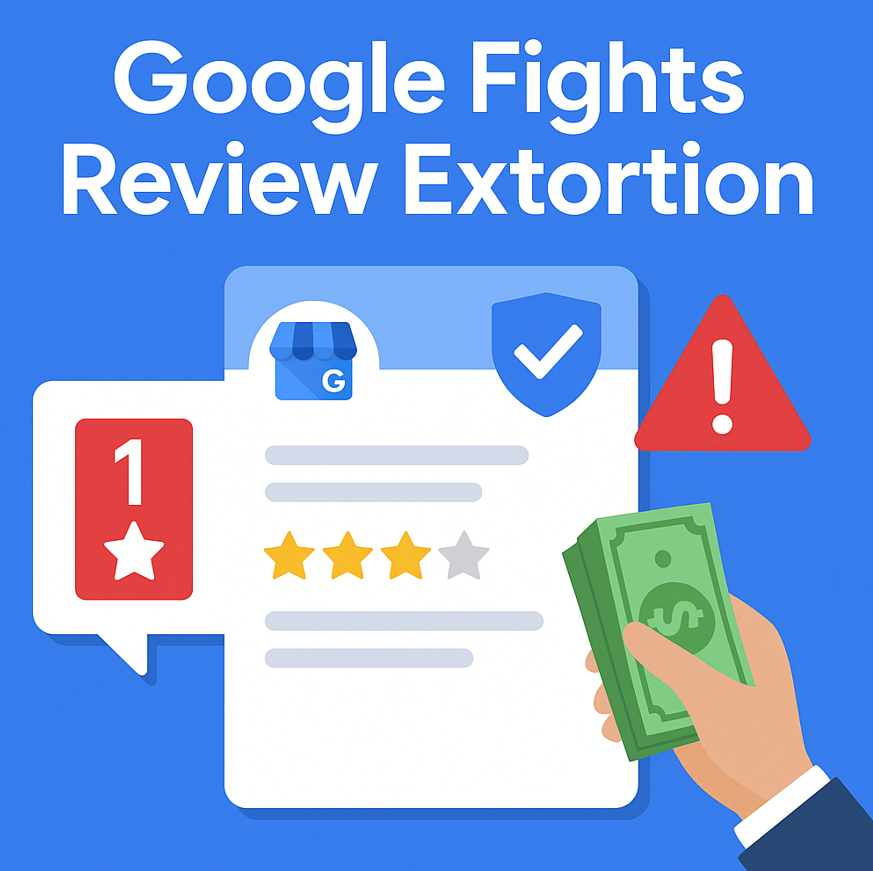Introduction: When Online Reviews Turn Into a Threat
Online reviews are meant to reflect customer experiences — a powerful tool that influences purchasing decisions, local SEO rankings, and a business’s overall credibility.
But in recent years, a darker trend has emerged: review extortion scams, where attackers post fake negative reviews and then demand payment to remove them.
Recognizing the growing damage this causes to genuine businesses, Google stepped in last month with a new dedicated form to help victims report review-based extortion attempts — and early feedback suggests it’s working.
The Rise of Review Extortion: A Modern-Day Digital Ransom
What is Review Extortion?
Review extortion is when malicious individuals or groups intentionally leave a series of false, damaging 1-star reviews on a business’s Google listing.
Afterward, they contact the business with messages like:
“Pay us, and we’ll remove the reviews — or else more are coming.”
This form of digital blackmail has become alarmingly common across industries: restaurants, law firms, hotels, service-based professionals, and even local shops.
Why It’s So Dangerous
Reputation damage: A few bad reviews can instantly lower your overall star rating.
Revenue loss: Potential customers often skip businesses with low ratings.
Search ranking drop: Google’s local ranking algorithm considers ratings, meaning fake reviews can hurt visibility.
Psychological stress: For small business owners, these attacks feel deeply personal and helpless.
Google’s Proactive Move: A Dedicated Reporting Form
The New “Report Extortion” Tool
In October 2025, Google quietly launched a special reporting form dedicated to combating review-based extortion.
Businesses can now submit evidence of fake reviews linked to extortion attempts, such as threatening emails, WhatsApp messages, or coordinated review patterns.
“We’re committed to protecting businesses from deceptive and coercive practices. This new reporting pathway helps us identify and remove content tied to extortion faster.”
— Google Safety & Security Team, November 2025
Why It Matters
It formally acknowledges review extortion as a separate abuse type (not just spam).
It enables faster human review by Google’s Trust & Safety team.
It helps restore business profiles affected by targeted campaigns.
It sends a clear signal that Google is taking reputation-based crimes seriously.
How the Scam Works: Step-by-Step Breakdown
Fake Reviews Flood In:
Attackers post 1-star reviews with vague or repetitive complaints (e.g., “Bad service,” “Terrible experience”) to look legitimate.Extortion Message Arrives:
Within 1–2 days, the business receives an email or message demanding money or products to “fix” their rating.Threat of Escalation:
The attacker warns that refusing will lead to more negative reviews or social media defamation.Damage Done:
The fake reviews remain visible until reported — costing the business trust, customers, and local ranking.
 How to Protect Your Business
How to Protect Your Business
Step 1: Don’t Engage or Pay
Never negotiate with or pay an extortionist. Paying once usually triggers repeat attacks or wider targeting.
Step 2: Collect Strong Evidence
Save everything:
Screenshots of fake reviews (with timestamps).
Copies of any emails, texts, or DMs.
Your Google Business Profile link and original rating before the attack.
Step 3: Use Google’s “Negative Review Extortion” Form
Here’s how to submit:
Visit the official Google Business Profile Help Center.
Locate the “Report Extortion or Negative Review Scam” form.
Fill in your business details, attach evidence, and submit.
Tip: The more context you provide (dates, messages, screenshots), the faster Google can act.
Step 4: Keep Monitoring
Track your profile daily for new suspicious reviews.
Report any coordinated activity promptly.
Use Google Alerts or third-party tools for instant notifications.
Step 5: Strengthen Legitimate Reviews
Encourage real customers to share honest experiences.
Authentic, positive feedback helps dilute fake reviews and rebuilds trust naturally.
Early Results: “It Seems to Work”
SEO professionals and small business owners who’ve used the new form report promising outcomes.
According to Search Engine Land (Nov 2025), many users saw fake reviews removed within days after filing extortion complaints.
Some agencies managing multiple client profiles also noted reduced recurrence once the reports were verified — suggesting that Google’s detection algorithms are improving.
Expert Tip: Don’t Just React — Prepare
Businesses should include review protection in their digital marketing and SEO plans.
Here’s how:
Set up a weekly review audit routine.
Maintain a crisis response checklist for fake reviews.
Train staff on how to identify extortion attempts early.
Keep a PR response plan ready to handle potential media fallout.
Conclusion: Google’s Form Is a Step Toward Digital Fairness
Review extortion isn’t just a nuisance — it’s a threat to digital integrity.
By providing a formal reporting system, Google has finally recognized how real and damaging this issue has become.
For businesses, this means greater control over their online reputation and a path toward justice when unfairly attacked.
In the evolving digital landscape, trust is your currency — and tools like Google’s extortion report form are your best defense.






